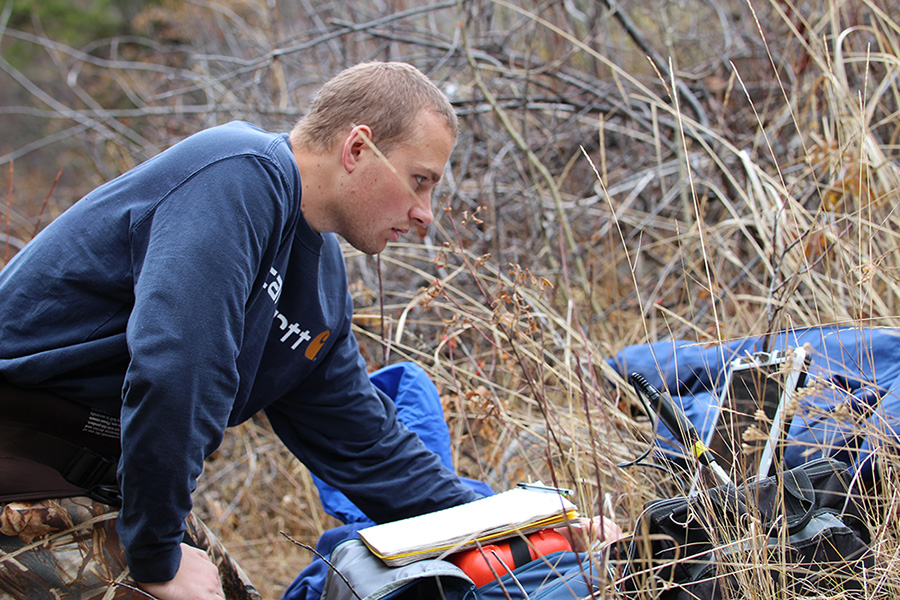UWRL Outstanding Student Spotlight Hyrum Tennant
Each month the UWRL takes a moment to highlight an outstanding student, faculty member, or alumni. This month our spotlight is on Hyrum Tennant, a graduate student studying Civil and Environmental Engineering at Utah State University.

Hyrum Tennant works with UWRL Professor Beth Neilson conducting research on the Logan River in conjunction with the Logan River Observatory (LRO). The LRO is a collaborative research organization that collects and shares data from the Logan River watershed in Cache Valley. This data can then be accessed by the public and can help inform future state-wide water management decisions or provide others with data for their water research.
Professor Neilson commented on her work with Hyrum, saying “Hyrum’s curiosity about rivers and their connectivity to groundwater has been a key driver for his research. He has collected vast quantities of hydrologic data in the Logan River watershed to help answer basic, yet complicated research questions due to the underlying karst geology in this watershed. Without hesitation, he invests the time required to collect different types of data that may provide evidence needed to reveal key hydrologic processes. Historically many have avoided studying the Logan River because of its complexity. In contrast, Hyrum finds it fascinating and his tenacious approach to answering his research questions has proven successful in unraveling some the inherent complexities within the Logan River.”
Hyrum received his undergraduate degree from USU, where he was a College of Engineering Ambassador, an Undergraduate Research Ambassador, and an Undergraduate Research Advisory Board member. Hyrum also won the Engineering Undergraduate Research Program award in 2016, and then the College of Engineering Undergraduate Researcher of the Year Award in 2017.
We recently sat down to learn more about Hyrum and his research at the UWRL:
What inspired you to choose this field of study?
Before I started working with Dr. Neilson and her group of students, I was deciding between majoring in an engineering degree or pursuing a mathematics degree and becoming a high school teacher. I was able to work on several different projects with Beth’s students before starting my freshman year, and that it gave me the chance to discover how interesting hydrology and environmental engineering are to me and how much I like research. However, what probably inspired me the most was working with a great group of graduate students; Trinity Stout, Michelle Barnes, Noah Schmadel, Tyler King, and Milada Majerova.
Tell us about your research/fieldwork with the LRO:
Climate change is predicted to reduce the baseflow of surface waters in the watersheds of the Intermountain West. This will impact both the streamflow and water quality of rivers and streams. Within the Logan River watershed this is of particular concern because of the magnitude of the inflows and outflows to the Logan River. In Logan Canyon, the large fractures, conduits, and sinkholes created by the canyon’s karst geology convey most of our winter snowpack to the river; however, the geology also simultaneously facilitates significant losses of streamflow from the river.
The concern is that as we transition to a lower snow-to-rain ratio due to climate change, the magnitude of the karst inflows will significantly decrease while the magnitude of the streamflow losses will remain high. My research is focused on quantifying these inflows and outflows to the streamflow on both a temporal and spatial scale. I am also working to quantify the inflows and outflows from agricultural and urban surface and subsurface return flows to the Logan River within the valley. Similar to within the canyon, as the baseflow of the river decreases we will be increasingly dependent on return flows to maintain in-stream flows. We are already observing short sections of the river being completely dewatered due to large diversions of streamflow for urban and agricultural irrigation, but the streamflow is quickly replenished by surface and subsurface return flows. As with the canyon, the concern is that, due to the diversion of streamflow for irrigation purposes or due to future management decisions that may reduce return flows, sections of the river will continue to be dewatered beyond what is currently occurring. This would not only impact streamflow but significantly impact water quality and stream ecology. All of this research is being done in conjunction with the Logan River Observatory at the UWRL.

Hyrum Tennant uploading data from a sensor placed in the Logan River.
What is your favorite part of your research?
I enjoy solving problems and asking questions, whether they are big-picture questions like my research questions or small problems like repairing equipment. The LRO has sensors all over the watershed, and as we frequently collect samples, there are always problems and questions to resolve on a daily basis just to keep things running. I enjoy getting to solve these research questions and problems while working closely with a great group of people.
What is the most challenging part of your research?
The most challenging part of my research is keeping the big picture in mind while performing the repetitive and mundane tasks (like data quality control) that result in good research.
What is the most helpful advice you’ve received during your time as a student?
Say no. I tend to over-allocate my time in order to help other people and it tends to hurt my own work in the long run so saying “no” is a skill I am having to develop.
What are your career goals?
My goals are undetermined at this point. I am deciding between pursuing a Ph.D. in water resources engineering or other career alternatives. I go back and forth between options several times a day.
Learn more about the Logan River Observatory Here

